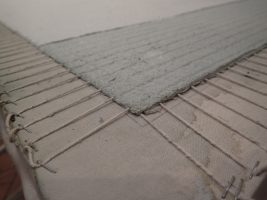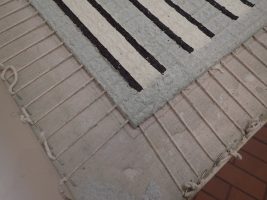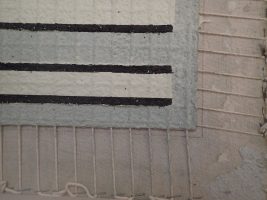28.09.16
Blogger: Jessie Cohen
Tomorrow we launch DE DIVITIIS, Lynda Ballen‘s second solo show with DKP for which the artist continues her engagement with the natural wealth yielded from earth’s surface with an enchanting series of 40 new drawings and prints.
Ballen’s previous exhibition, Concerning Preciousness (2012), looked at metals and gems as capital. For this show, she focuses on the value of pigments derived from the earth’s crust and recognizes these materials as precious.
All works reference geological structures and excavations to depict fictional places that encourage a visual and psychological journeying. They are an invitation to metaphysically traverse land and oceans in search of treasure.


A major part of Ballen’s creative process is physically making the paper on which she applies these intricate scenes. The handcrafted paper is made from reconstituted natural fibre – tinted with raw pigment (greens, blues, browns, yellows and greys) and laminated over a matrix of thread – to support the ink drawings (see images below). This process reinforces her purpose to allude to the earth’s mantle.
Ballen is attentive to the often overlooked fact that paint and ink are made from pigment. She points to this by inserting pure colour and tone in and amongst her line drawings as geometric shapes and pattern which are woven into her grid of weft and warp to reference textile heritage.
In this enchanting selection of work, Ballen deploys mark-making conventions typically used for intaglio and relief printmaking. What makes her work unique is that these drawings are applied to handcrafted pieces of paper to emphasize the significance of the paper itself. Even in Ballen’s editioned prints, which feature in this show, each piece of paper is distinctive.
At its core, this exhibition highlights the very process of production: from excavating material to making paper to constructing an image. As the title – DE DIVITIIS – indicates, this show stakes a claim for the value of the earth and the riches mined from it to make materials that are all too often taken for granted. In doing so, Ballen honours craftsmanship and the harnessing of the creative imagination in artistic enterprise.
It is also interesting to note that all pigments used in these works are derived from soils and rocks rather than plants and animals. Some of the pigments, such as Ochre, Sienna, Umber, are from Palaeolithic times and are common, whilst others, such as Ultramarine, Malachite and Orpiment, are pre-Renaissance and are rare and expensive. Ballen’s natural landscape imagery references the fact that these pigments have been traded and used in textiles and are therefore a form of currency.
This proliferation of work is sequenced according to Ballen’s personal sense of aesthetic to read like a tapestry so the eye travels seamlessly across stripes, squares and landscape scenes as if one is reading an illustrated book. There’s also a vertical visual journeying at play, which is a nod to the Japanese format of looking at landscapes that is informed by an Oriental sense of perspective.


